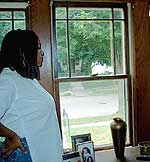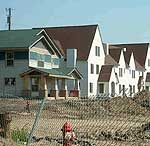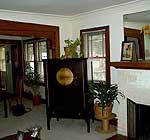By Brandt Williams
Minnesota Public Radio
September 17, 2002
The latest census figures released this week show a wide gap in the values of homes owned by African Americans, Native Americans and Hispanics than those owned by white Minnesotans. State demographers say the disparity may be caused by a number of factors. But whatever the causes, the disparity could perpetuate the economic gap for future generations of Minnesotans of color.
| |
|
|
|
||
For most Americans, the value of their home is their prime source of wealth. Families often use that wealth to send their children to college, or help their children put down payments on their own homes.
During the 1990s, a booming economy and buyer-friendly housing market helped many Minnesotans build thousands of dollars in home equity. They were able to buy at low prices and watch the value of their homes skyrocket.
One of those people is Shari Staples. Ten years ago, she bought a three-bedroom bungalow in a predominantly black neighborhood in north Minneapolis for just over $41,000. It has now more than doubled in value.
"I never ever thought I'd see this house valued at $100,000," says Staples. "And knowing that I could actually get more than than if I put it on the market - that's what the city values it at."
Staples is a single African American woman. She says she doesn't make a lot of money, and doesn't think she'd be able to afford the same house if she were looking to buy today. As of July of this year, the median home price in the Twin Cities was estimated at $190,000.
| |
|
|
|
||
"The families who bought their houses through our program in the early and mid-'90s - I think about how lucky they are. They got in right in time," says Jordan Ash, who heads the housing education wing of ACORN, a social justice group which helps low-income people buy homes.
The statewide median household income for African Americans and Native Americans increased over the past decade, but it still lags far behind that of whites and Asians. As a result, Ash says, low income homebuyers have fewer options of where they can buy a house.
"Families that we work with that qualify for a loan in the low hundred-thousands, there's certain areas then that are de facto - if you want to find a house at the low end, that's where it's going to be," says Ash.
"It really has to do with prevailing patterns of racial prejudice that exist in society at large, but that are also really manifest in housing markets," says University of Minnesota professor Edward Goetz.
Goetz says economic disparities such as those outlined in the census, coupled with historic problems like racism, help create low-income largely segregated neighborhoods. Goetz says home values remain lower in those neighborhoods than in predominantly white areas, where the demand for homes is higher.
| |
|
|
|
||
"If 80 percent of potential homebuyers in the Twin Cities metro area are white, and they voluntarily remove themselves from certain markets - the predominantly minority markets - that is going to significantly suppress the demand for those housing units. And when that happens, the value of those housing units decline as well," says Goetz.
Census figures show the statewide median home value for African Americans is $106,000, which is slightly higher than for Hispanics. American Indians have the lowest statewide median home value, at $78,000. Asian American home values remain slightly higher than that of whites. In Hennepin County, home of the state's largest concentration of people of color, African American home values are the lowest at $103,000.
Goetz says institutional racism, in the form of redlining and restrictive covenants which banned white homeowners from selling their homes to people of color - popular in the first half of the 20th century - helped create segregated neighborhoods.
Goetz says residents in these neighborhoods pay a penalty he describes as a "segregation tax."
"It's essentially a tax of anywhere from 10 to 30 percent - sometimes nearly 40 percent - on people who own a home in a predominantly minority neighborhood," Goetz says. "Because that's the degree to which their home values suffer in relationship to home values in predominantly white neighborhoods."
Goetz says this gap in home values will feed future economic gaps between whites and people of color, because home equity is passed on from generation to generation. The 2000 census doesn't reveal the amount of equity Minnesotans have in their homes. However, figures do show that home value disparities are widening.
In 1990, white home values were 3 percent higher than those of Hispanics and 6 percent higher than for African Americans. In 2000, those gaps increased to 12.5 percent for African Americans and 13 percent for Hispanics.
More from MPRMore Information



